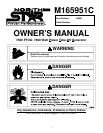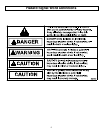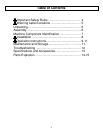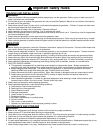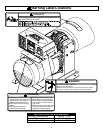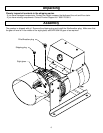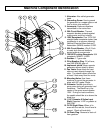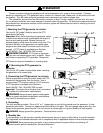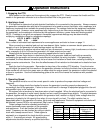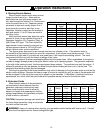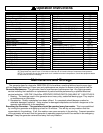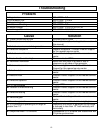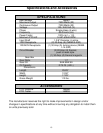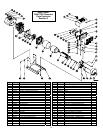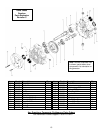
9
Load Output
Percent of
Generator
Output
Speed
(RPM)
Frequency
(Hz)
Generator
Voltage at 120V
Receptacle
0% 3780 63.0 125V
50% 3600 60.0 122V
100% 3480 58.0 118V
Operation Instructions
1. Engaging the PTO
While seated on the tractor and the engine at idle, engage the PTO. Slowly increase the throttle until the
needle in the generator voltmeter is at or above the black line in the green area.
2. Applying a Load
It is important to determine the total electrical load before it is connected to the generator. Always compare
the generator nameplate data with that of the equipment to be used to ensure that watts, volts, amperage, and
frequency requirements are suitable for operating equipment. The wattage listed on the equipment nameplate
is its rated output. However, some equipment may require three to ten times more wattage than its rating on
the nameplate, as the wattage is influenced by the equipment efficiency, power factor and starting system.
NOTE: If wattage is not given on equipment nameplate, approximate wattage may be determined by
multiplying nameplate voltage by nameplate amperage.
VOLTS X AMPS = WATTS
Example: 120V X 5A = 600W
Also, a chart of estimated load requirements for some appliances and tools is shown on page 11.
When connecting a resistive load such as incandescent lights, heaters or common electric power tools, a
capacity of up to the generator full rated wattage output can be used.
When connecting a resistive-inductive load such as a fluorescent or mercury light, transformers or inductive
coils, a capacity of up to 0.6 times the generator’s full rated output can be used.
Always allow the generator to reach operating speed before a load is applied.
Important: The two major factors in determining the life of a generator head are heat build up caused by
overloading the generator and corrosive contaminants that attack the wiring insulation. If the generator is
overloaded, the wires become excessively hot and cause the insulation to break down, reducing its ability to
resist corrosive contaminants. Over time the effectiveness of the insulation is eliminated and a dead short can
result.
Apply the load to the generator. Remember to stay clear of the rotating PTO driveline. From the tractor
seat re-adjust the speed until the needle on the generator voltmeter is close to the black line in the green area.
If the needle will not rise to the green area no matter what the engine speed, the generator is either overloaded
or there is a problem. Use the troubleshooting guide at the end of the manual for assistance with possible
problems.
3. Operating Speed
The generator must be run at the correct speed in order to produce the proper electrical voltage and
frequency.
The output voltage should be checked to ensure the generator is working properly subsequent to
connecting a load to the generator. Failure to do so could result in damage to equipment plugged into the unit
and possible injury to the individual.
All engines have a tendency to slow down when a load is applied. When the electrical load is connected to
the generator, the engine is more heavily loaded, and as a result the speed drops slightly. This slight decrease
in speed, together with the voltage drop within the generator itself, results in a slightly lower voltage when the
generator is loaded to its full capacity than when it is running with no load. The slight variation has no
appreciable effect in the operation of motors, lights and most appliances. Electronic equipment and clocks will
be affected if correct RPM is not maintained. See Load vs. Output chart.
Output voltage should be checked periodically to
ensure continued proper operation of the generator
and appliances. It can be checked with a portable
meter. Frequency can be checked by using an electric
clock with a sweep second hand. Timed against a
wristwatch or a stopwatch the clock should be correct
within +/- 2 seconds per minute. All speed setting
adjustments should be done by a qualified technician.



